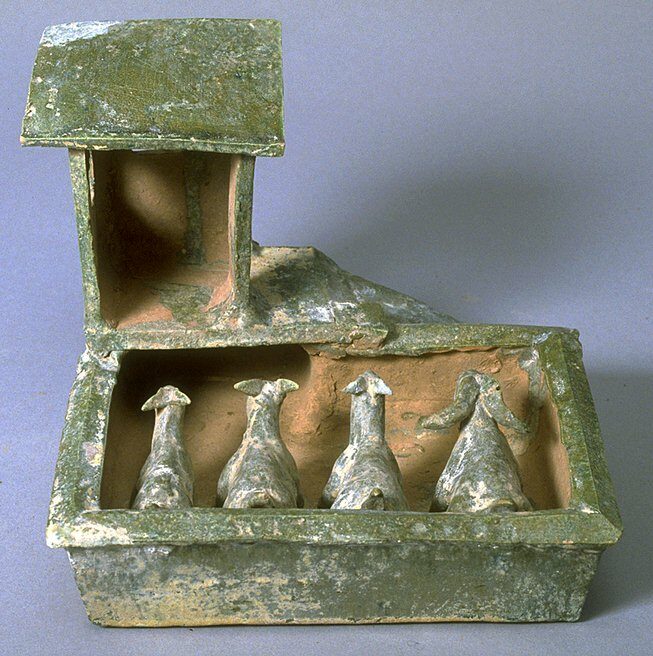Goat Pen
Chinese

Description
This well-modeled miniature shows a goat family -- three ewers and a ram—in their pen anxiously watching for their master to appear in the upper compartment to let them out to pasture. This kind of realistic physical and psychological detailing helps make Han mortuary models charming and accessible to viewers today.
Han mortuary objects were made of earthenware, glazed or unglazed. Unglazed objects were hand painted with white slip or black, orange, and red pigments as seen in the pottery dog displayed adjacently (1993/1.96). The glazed objects, like this goat pen, used lead as the fluxing agent and iron and copper oxides, respectively, as colorants to make russet and green glazes. Lead glazes are poisonous for both potter and user, and the mortality rate for potters attracted to this bright glaze was high. Fortunately pots with lead-based glazes were confined to burial objects throughout Chinese history.
(Label for UMMA Chinese Gallery Opening Rotation, March 2009)
Subject Matter:
By the Western Han dynasty, basic household bowls, plates, basins, jars, etc. were produced in great quantity, not only for use in daily life, but also specifically for tombs as mingqi (明器)(literally "bright objects"), or grave goods, as a way to provide for the deceased. These mingqi included everything one would need during the afterlife. Naturally, these objects reflected daily life during the Han. Mingqi could include houses, towers, gates, granaries, livestock pens, chicken coops, wells, cooking stoves, storage vessels, dishes, incense burners, lamps and figures such as horses, dogs, anthropomorphic animals, and people such as officials, guardians, servants and entertainers, and more. The number of ceramic mingqi items in a tomb could reach numbers of a few to several hundred objects.
During the Western Han, it was common for northern potters to create pigsties as mingqi, by the Eastern Han, a variety of domesticated livestock in their pens could be found in tombs.
Physical Description:
A red earthenware ceramic model of a goat pen, containing one ram and three ewes, with a small shed over the pen with stairs. The exterior and goats are covered in a green lead glaze with iridescence and calcification.
Usage Rights:
If you are interested in using an image for a publication, please visit https://umma.umich.edu/request-image/ for more information and to fill out the online Image Rights and Reproductions Request Form.